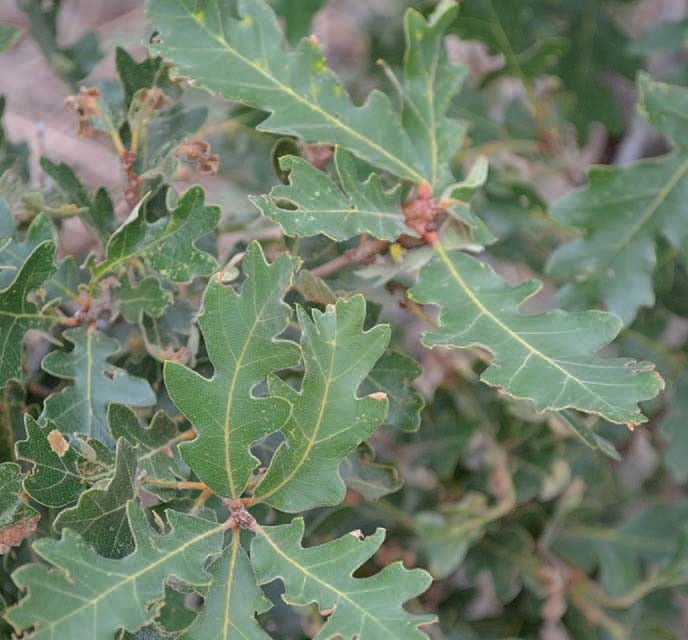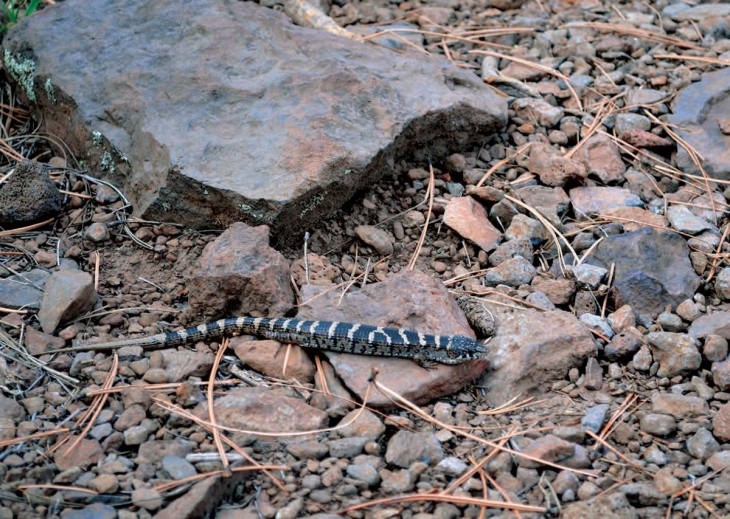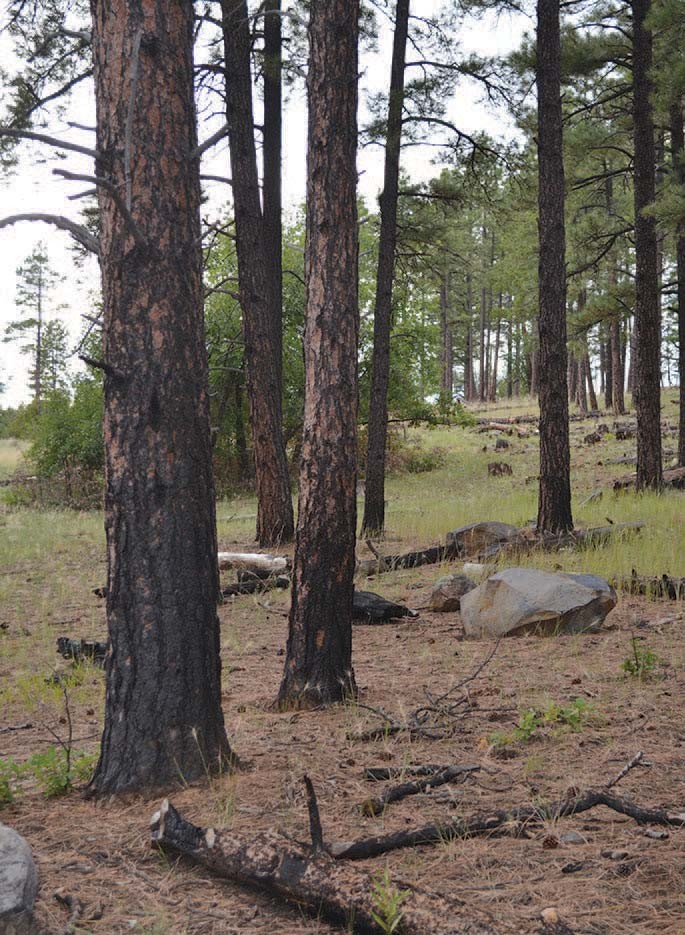
A cloud of reddish dust rose behind our car as we drove down a series of dirt U.S. Forest Service roads southeast of Williams, Arizona. It was September 2019, and we were headed for a hike at Sycamore Canyon instead of fighting the crowds at the Grand Canyon for a second day. The surrounding Kaibab National Forest was mostly ponderosa pine with grasses growing beneath. Scattered stumps attested to past logging. At one point we passed a large flock of sheep on open grassland, and some places in the forest looked like they had been grazed as well; the Forest Service issues permits for rotational grazing.
After about 13 miles, we reached the trailhead parking for Sycamore Canyon Vista and because we’d be hiking in rattlesnake country, donned the knee-high snake gaiters we had purchased for our trip. The trail led through a forest with many fire-scorched tree trunks and charred logs. Despite their blackened trunks, most of the ponderosa pines looked healthy.
Ponderosa pines are important timber trees in the Southwest. Their appearance is shaped by the trees’ long coexistence with fire. The young pines develop a protective, corky bark when only a couple of inches in diameter, and mature trees have large plates of thick, reddish orange bark that flakes off when on fire. Ponderosa pines also have deeper roots than other western conifers – roots that can survive surface fires. Their needles, about eight inches long and bundled in groups of two or three, have high moisture content and buds have thick scales that shield them from heat. Their open crowns allow heat to dissipate.
Historically, frequent, low-intensity fires started by lightning strikes burned through these forests. But in the 1800s, intensive grazing by domestic livestock removed the grasses that spread these surface fires and early settlers suppressed fires to protect their homes. Today, the Kaibab National Forest contains dense stands with an unnaturally high proportion of young trees, and fewer grasses and shrubs that provide forage for wildlife such as deer and elk. As a result, the woodlands are at high risk for insect and disease outbreaks and severe wildfires due to the buildup of woody material.
The Forest Service has been working with the Ecological Restoration Institute at Northern Arizona University to restore the historic fire regime of frequent, low-intensity fires through thinning and prescribed burns. It also allows natural wildfires to burn when conditions are favorable. Some of the stumps and the brush piles we had witnessed as we drove were due to mechanical thinning. The area we were hiking through had experienced a fire a dozen years ago, and west of Sycamore Canyon, the Forest Service had conducted the Sunflower Prescribed Fire Project over 15,000 acres during the past two years.
Continuing on the trail, we spotted a creature the same color as the pinkish orange soil. With its broad, spiny back and short tail, it looked like a cross between a toad and a lizard. We later found out it was a horned lizard. Small animals such as lizards that are not highly mobile will shelter from fires in underground burrows.
We soon reached the edge of the canyon, passing into the 55,937-acre Sycamore Canyon Wilderness Area that stretches south toward Cottonwood. This remote place was designated Arizona’s first wilderness area in 1972. Shaped over eons by Sycamore Creek, the canyon includes one of the world’s rarest habitats: a desert riparian area. Here at its northern end, the canyon is narrow and twisted. In contrast to the relatively open and recently burned ponderosa pine forest we’d been hiking through, the canyon was densely wooded; the fire appeared to have stopped at the rim. In addition to the ubiquitous ponderosa pine, the moister canyon supported different vegetation. We could see the pointed spires of Douglas fir and light green patches of deciduous trees such as cottonwood and sycamore below.
Because there were no trails into the canyon, we walked along the rim trail toward Sycamore Falls. Despite – or perhaps because of – the fairly recent fire, there was a lot of life along the rim. Several turkey vultures soared on the thermals that rose from the canyon, spiraling upward. Red squirrels peeped and chattered from high in ponderosa pines as we passed below. Stripped cone cobs littering the ground indicated that they’d been feeding on pine seeds. Smaller pinyon pines also grew here. There was a flash of blue as a Steller’s jay – a cousin to our blue jay and a lover of pinyon pine nuts – flew by. We passed Utah juniper trees laden with light blue, berry-like cones and clumps of Gambel oak shrubs. All of these plants are adapted to the dry soils found here; the juniper and Gambel oak can reestablish themselves from root sprouts after a fire.
As we hiked along, we saw several different species of small lizards with long tails sunning themselves on rocks or darting into the bushes. “Keer!” – the piercing cry of a red-tailed hawk broke the silence. In the distance, we could see a couple of mountains – extinct volcanoes. The area we were hiking through is located along the edge of what geologists call the San Francisco Volcano Field. Many chunks of rhyolite, a volcanic rock, provided evidence of past volcanic activity. These rocks were riddled with holes called vesicles, formed from the expansion of gas bubbles as lava from a vent or volcano cooled and solidified.
Piles of dried deer pellets indicated that mule deer had spent a lot of time here, perhaps wintering on the canyon rim. Coyotes had more recently deposited their pointed scat on the trail. Smaller scat with seeds may have been left by one of the ringtail “cats” that inhabit the canyon. The ringtail, Arizona’s state mammal, is a smaller relative of our raccoon with a longer ringed tail.
After two miles, we reached Sycamore Falls at the head of a narrow side canyon. Except for a few pools below the falls, the creek bed was dry. There are few permanent streams in this part of Arizona; this creek only carries water from spring snowmelt and heavy rains.
We crossed the dry creek bed to an overlook on the other side of the canyon. Suddenly, what looked like a small snake with yellow bands slithered into a rock pile beside the trail. However, my husband noticed that it had tiny feet – the creature was actually a lizard. We saw two more nearby and later learned they are Arizona alligator lizards. This species of lizard is able to cast off and regenerate its tail; predators and human pursuers often end up with nothing but a wiggling tail.
The Forest Service’s efforts to restore this ponderosa pine forest and to increase diversity through prescribed burns and thinning seem to be working. On our drive back through the Kaibab National Forest in late afternoon, we were treated to the sight of a small herd of elk cows and calves browsing on the grasses and shrubs that had sprung up after a fire, rejuvenating the forest.





Discussion *